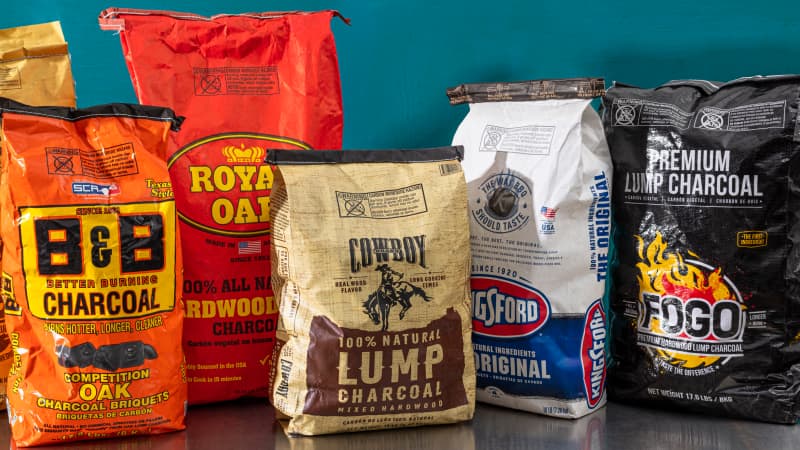Charcoal Grills
Equipment Review
We love cooking on charcoal. Is one type better than another?
Published Sept. 21, 2022. Appears in Cook's Country TV Season 16: Texas Cookout

Charcoal has a primal appeal. It’s one of the oldest manufactured cooking fuels, with production dating to at least the Iron Age. As ancient humans learned, charcoal is a more efficient fuel source than wood. It’s lighter, more portable, and burns more evenly.
Charcoal burns hotter than gas and produces a lot of radiant heat, which enables superior browning. Many prefer the taste of food cooked over charcoal, as the charcoal produces smoke that contributes a savory “grilled” flavor to food, making it especially delicious.
In the United States, charcoal is typically made from wood. There are two types: lump (aka hardwood) and briquettes. Both are byproducts of the lumber industry. Lump resembles the wood it comes from. Briquettes, the form of charcoal most Americans use today, are compact pucks made from sawdust and other materials.
The process for making the two is mostly the same: wood or sawdust is heated slowly at high temperatures in ovens or kilns with little or no oxygen. This drives off water, gases, and other substances, leaving behind what we cook with: char, a solid substance that is composed mostly of carbon. With briquettes, there are extra production steps. The charred sawdust is mixed with wood fiber, starches, minerals, and other ingredients and then compressed.
So, does it matter which kind of charcoal you use? To find out, we tested five of the most popular brands according to IRI, a Chicago-based market research firm, two brands of briquettes and three brands of lump. We ran heat tests and used each to cook a variety of foods. Dr. Laura Hasburgh and Dr. Kara Yedinak at the USDA’s Forest Products Laboratory (FPL), the national leader in scientific research on wood and wood products, helped us run additional tests and answered all of our burning questions.
To kick off our research, we turned out bags of each brand and sorted the pieces by size. The briquettes were incredibly uniform, with very few broken pieces or powder in the bags. By contrast, the lump charcoal we tested varied a lot, not only from brand to brand but also within the same bag. One brand contained mostly 4-inch cubes of wood, while another had pieces ranging from powder and pea-size chips to large 7-inch slabs. Size matters: Charcoal smaller than about an inch and a half can fall through your chimney starter or grill grates, rendering those pieces unusable. About 20 to 50 percent of the lump charcoal in the bags we surveyed were too small to use (or contained unusable foreign objects such as rocks).
Some lump charcoal enthusiasts claim that lump bur...

The mission of America’s Test Kitchen Reviews is to find the best equipment and ingredients for the home cook through rigorous, hands-on testing. We stand behind our winners so much that we even put our seal of approval on them.

Miye is a senior editor for ATK Reviews. She covers booze, blades, and gadgets of questionable value.

This is a members' feature.